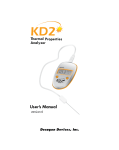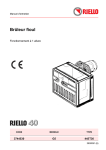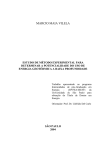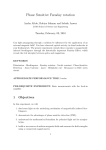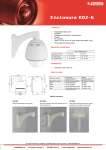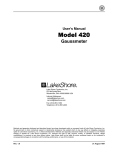Download KD2
Transcript
KD2 Thermal Properties Analyzer User’s Manual version 1.7 Decagon Devices, Inc. ©2006 Decagon Devices, Inc. All rights reserved. Decagon Devices, Inc. 950 NE Nelson Court Pullman WA 99163 KD2 User’s Manual Table of Contents Table of Contents 1. Introduction . . . . . . . . . . . . . . . . . . . . . . 1 About the KD2 . . . . . . . . . . . . . . . . . . . . . 1 KD2 Specifications . . . . . . . . . . . . . . . . . 2 Contact Information . . . . . . . . . . . . . . . . 2 Warranty Information . . . . . . . . . . . . . . . 3 Seller’s Liability . . . . . . . . . . . . . . . . . . . . 3 2. Operation . . . . . . . . . . . . . . . . . . . . . . 5 Turning it on . . . . . . . . . . . . . . . . . . . . . . .5 Taking Measurements . . . . . . . . . . . . . . .5 How the KD2 takes measurements . . . . 11 3. Care and Maintenance . . . . . . . . . . 13 Cleaning . . . . . . . . . . . . . . . . . . . . . . . . . 13 Battery Replacement . . . . . . . . . . . . . . . 13 Caring for the Probe . . . . . . . . . . . . . . . 15 Troubleshooting . . . . . . . . . . . . . . . . . . . 15 Verifying Probe Function . . . . . . . . . . . . 16 4. Theory . . . . . . . . . . . . . . . . . . . . . . . . 18 Further Readings . . . . . . . . . . . . . . . . . . .23 i KD2 User’s Manual Table of Contents Appendix A: Table of Thermal Units .25 Declaration of Conformity . . . . . . . . . 26 Certificate of Quality Assurance . . . . . . . . . . . . . . . .27 ii KD2 Operator’s Manual Introduction 1. Introduction Welcome to your new KD2 Thermal Properties Analyzer. This guide is designed to help you understand and use your instrument to the best of its capability. About the KD2 Pro The KD2 is a compact, portable meter used to measure thermal properties. It consists of a handheld readout and a single-needle sensor that can be inserted into the medium you wish to measure. A reading is initiated by pressing the left button on the readout. The controller waits for 30 seconds to ensure temperature stability, then heats the probe for 30 seconds. It then monitors the cooling rate for 30 seconds. At the end of the reading, the controller computes the thermal conductivity based on the measurements made during the heating and cooling periods of the probe. This data is used to calculate thermal conductivity and thermal resistivity. Further details about the measurements and how they’re made are given in chapters 2 and 3 of this guide. 1 KD2 Operator’s Manual Introduction KD2 Specifications Measurement Speed: 1.5 minutes Accuracy*: • 5% Thermal Conductivity/Resistivity *Certificate of Quality Assurance is located at the end of the index of this manual. Power: 3.0V CR2-type lithium-ion battery Weight: 148g (5 oz.) Operating Environment: -20 to 60°C Range of Measurement: • K (thermal conductivity): 0.02—2 Wm-1C-1 • R (thermal resistivity): 0.5—50mC W-1 Sensor: • Needle length: 60mm • Needle diameter: 1.28mm • Cable length: 72cm (additional lengths available upon request) Contact Information If you need to contact Decagon for customer support or any other questions, you can reach us by any of the following: • E-mail us at [email protected] • Send us a fax at: (509) 332-5158 2 KD2 Operator’s Manual Introduction • Call us at: 1-800-755-2751 (US and Canada only) or 509-332-2756. Warranty Information The KD2 has a 30-day satisfaction guarantee and a one-year warranty. Seller’s Liability Seller warrants new equipment of its own manufacture against defective workmanship and materials for a period of one year from date of receipt of equipment (the results of ordinary wear and tear, neglect, misuse, accident and excessive deterioration due to corrosion from any cause are not to be considered a defect); but Seller’s liability for defective parts shall in no event exceed the furnishing of replacement parts F.O.B. the factory where originally manufactured. Material and equipment covered hereby which is not manufactured by Seller shall be covered only by the warranty of its manufacturer. Seller shall not be liable to Buyer for loss, damage or injuries to persons (including death), or to property or things of whatsoever kind (including, but not without limitation, loss of anticipated profits), occasioned by or arising out of the installation, operation, use, misuse, non-use, repair, or 3 KD2 Operator’s Manual Introduction replacement of said material and equipment, or out of the use of any method or process for which the same may be employed. The use of this equipment constitutes Buyer’s acceptance of the terms set forth in this warranty. There are no understandings, representations, or warranties of any kind, express, implied, statutory or otherwise (including, but without limitation, the implied warranties of merchantability and fitness for a particular purpose), not expressly set forth herein. 4 KD2 Operator’s Manual Operation 2. Operation The KD2 is designed to be a simple, easy to use instrument that will allow you to make quick and accurate thermal properties measurements. Following are some instructions on how the instrument functions. Turning it on To turn on the KD2, press the left button (I) once. The LCD display will appear, showing the previous measurement taken. Wm m-1 C-1 2 3.0 C | Taking Measurements The KD2 measures thermal conductivity, resistivity, and diffusivity at the same time from one measurement, but can only display one reading at a 5 KD2 Operator’s Manual Operation time after the measurement is made. The right (II) button is used to toggle through the calculated readings after the measurement has been made. To begin a measurement, press the left (I) button to turn on the instrument. The instrument will be in the same measurement mode as it was when it was last used (thermal conductivity or thermal resistivity mode) and will display the last reading taken. NOTE! It is important to wait for about 5 minutes between readings if the probe is left in the same location! If multiple measurements of a sample are made too rapidly in succession, the sample’s temperature will not have had enough time to equilibrate from the previous reading, and the resulting measurement will be inaccurate. For best results, the sample should be as close to equilibrium as possible. An ideal environment for equilibration can be accomplished by placing the KD2 probe and sample in an isothermal chamber or styrofoam box. Thermal Grease Thermal grease is provided as part of your KD2 system in order to maximize contact with certain samples. For example, contact resistance with gran6 KD2 Operator’s Manual Operation ule materials increases with particle size and particle conductivity. This can be minimized by coating the probes with thermal grease as per ASTM D5334 Section 7. For wet soil, thermal grease is not as necessary, since it can have little or no effect, due to the already optimized contact between the probe and sample. When in doubt about whether or not to use the thermal grease, take some measurements without it, then take some with the thermal grease. If the results show a higher thermal conductivity (lower thermal resistivity) when using the thermal grease, then we recommend that you use it for that particular sample. How to Start the Measurement Once the instrument is on, do the following: 1. Carefully insert the entire needle of the probe completely into your medium. 2. Press the left button to begin the measurement process. The instrument will first equilibrate for 30 seconds. During this time you will be able to see that it is equilibrating by the blinking “hourglass” icon below the value. The temperature measured by the probe will be displayed in the lower right corner of the 7 KD2 Operator’s Manual Operation screen: Wm m-1 C-1 2 0.0 C hourglass icon temperature Note! Make sure to watch the temperature during the equilibration stage to make sure it doesn’t drastically fluctuate or rapidly change. If the temperature is still rapidly changing, pull the probe out of the sample and wait until the sample temperature is stable before measuring again. 3. After equilibrating, it begins its 30-second heating and measurement cycle. During this stage of measurement you will see a blinking thermometer icon appear, and the temperature 8 KD2 Operator’s Manual Operation reading will increase: After it has finished heat- Wm m-1 C-1 2 7.0 C | thermometer icon ing, it will cool for 30 seconds. 4. When ther reading is finished, the checkered “finish line” flag will blink on the screen, and a final reading will be displayed along with the sample temperature: Wm m-1 C-1 2 3.0 C | “finished” icon 9 KD2 Operator’s Manual Operation Thermal Conductivity To display the measurement in terms of thermal conductivity, press the right (II) button until the thermal conductivity is displayed in Wm-1C-1 (watts per meter-degree Celsius): Wm m-1 C-1 2 3.0 C | Materials with Low Thermal Conductivity Since the KD2 only displays three digits, some users may want to see a higher-decimal accuracy, particularly when measuring materials with a low thermal conductivity (such as foams, insulation materials, etc.). To do this, we recommend collecting the data in the thermal resistivity mode, and then converting the data to thermal conductivity by taking its reciprocal. 10 KD2 Operator’s Manual Operation Thermal Resistivity To display the measurement in terms of thermal resistivity, press the right (II) button until the thermal resistivity is displayed in mC W-1 (meterdegrees C per watt): -1 m CW 2 0.0 C | If the value shown for thermal resistivity is 9.99, this indicates that your sample is out of range for the KD2 to measure. Turning it off The KD2 will shut off automatically after 5 minutes of inactivity. To turn it back on, press the left (I) button once. How the KD2 takes measurements The KD2’s sensor needle contains both a heating element and a thermistor. The controller module contains a battery, a 16-bit microcontroller/AD converter, and power control circuitry. 11 KD2 Operator’s Manual Operation When you begin a measurement, the microcontroller waits for 30 seconds for temperature stability, then applies a known amount of current for 30 seconds to a heater in the probe that has an accurately known resistance. The microprocessor calculates the amount of power supplied to the heater. The probe’s thermistor measures the changing temperature for 30 seconds while the microprocessor stores the data. It then monitors the rate of cooling for 30 seconds. At the end of the reading, the controller computes the thermal conductivity using the change in temperature (∆T) vs. time data. Thermal resistivity is computed as the reciprocal of thermal conductivity. 12 KD2 Operator’s Manual Care and Maintenance 3. Care and Maintenance Your KD2 should require a minimum amount of maintenance. Following are instructions for cleaning and battery replacement, as well as considerations for the KD2 probe. Cleaning The KD2’s controller is stainless steel. If it needs cleaning, do so with a damp cloth. Do not immerse it in water. Clean the LCD readout with a soft, damp cloth moistened with water or a glass cleanser. Do not use tissue or other wood-based fibers, as they can scratch the plastic LCD screen. Battery Replacement The KD2 uses a 3.0V CR-2 type Lithium-ion battery. It typically should last for about 1000 measurements. If the battery charge is getting low, a low-battery indicator icon will appear in the lower right corner of the LCD screen when the heater comes on (an occasional low battery indication 13 KD2 Operator’s Manual Care and Maintenance does not necessarily mean the battery needs replacing): Wm m-1 C-1 + 2 0.0 C | If this screen appears continually, do the following to replace the battery: 1. Unscrew the small screw on the back of the KD2 case. 2. Lift the back shell off to reveal the battery: battery location 14 KD2 Operator’s Manual Care and Maintenance 3. Remove the battery and replace it with the new one, making sure to orient the battery the same way you removed it. Caring for the Probe The KD2 sensor contains a heater and thermistor that are essential for the function of the instrument. Care should be taken to prevent bending the probe. The probe itself is stainless steel, so it may be cleaned with a wet cloth or sponge if it becomes dirty. Troubleshooting The KD2 is a fairly robust instrument that encounters very few problems or failures. Here is a list of possible problems and solutions: • Displaying a reading of 99.9°C, accompanied by no values for thermal properties: The thermistor in the probe has failed and you will need a replacement. If this occurs within the 1-year warranty, contact Decagon for a warranty replacement. • Poor or inconsistent readings: (1) The probe needle may not be inserted completely into the sample, or (2) the probe may be 15 KD2 Operator’s Manual Care and Maintenance touching the sides of the pot or container holding the material. Verifying Probe Function You can check whether or not your KD2 probe is functioning correctly by testing it in a reference media with known thermal properties. When measuring liquid media (such as water or castor oil) in a container, take care not to let the probe touch the side of the container to avoid an erroneous reading. Below is a table of various materials and their respective thermal properties: Table 1: Thermal Properties of Reference Materials K Temp Reference °C Wm-1C-1 Water: Glycerin: Castor Oil *Laser Comp polystyrene tm 17.6 0.61 20.0 0.286 19.6 0.17 12.5 0.032 *Laser Comp, 20 Spring St.,Saugus, MA 10906, USA (781) 233-1717 www.lasercomp.com 16 KD2 Operator’s Manual Theory Another medium that can be tested is a mixture of water and food thickener, such as Hormel® “Thick and Easy”tm food thickener. A mixture of 1 tsp (4.9ml) of thickener to 100ml of water will yield a thermal conductivity (K) of .56 Wm-1C-1 + .0018(t) where t is the temperature of the sample. To compare your results to the factory results taken when the KD2 was shipped, please refer to the Certificate of Quality Assurance certificate directly following the index of this manual. 4. Theory KD2 calculates its values for thermal conductivity (K) and resistivity (R) by monitoring the dissipation of heat from a line heat source. The equation for radial heat conduction in a homogeneous, isotropic medium is given by ∂ 2T ∂T ∂T = κ 2 + r −1 ∂t ∂r ∂r (1) 17 KD2 Operator’s Manual Theory where T is temperature (°C), t is time (s), κ is thermal diffusivity (m2 s-1), and r is radial distance (m). When a long, electrically heated probe is introduced into a medium, the rise in temperature from an initial temperature, T0, at some distance, r, from the probe is q T − T0 = 4πλ h − r2 Ei 4κt (2) where q is the heat produced per unit length per unit time (W m-1), λh is the thermal conductivity of the medium (W m-1C-1), and Ei is the exponential integral function 2 ∞ r2 r2 r2 1 + + ... − Ei(− a ) = ∫ exp(− u )du = −γ − ln − u 4κt 4κt 8κt a (3) with a = r2/4κt and γ is Euler's constant (0.5772…). When t is large, the higher order terms 18 KD2 Operator’s Manual Theory can be ignored, so combining Eqs. (2) and (3) yields r 2 q T − T0 ≅ ln (t ) − γ − ln 4πλ h 4 κ (4) It is apparent from the relationship between thermal conductivity and ∆T = T-T0, shown in Eq. (4), that ∆T and ln(t) are linearly related with a slope m = (q/4πλh). Linearly regressing ∆T on ln(t) yields a slope that, after rearranging, gives the thermal conductivity as λh ≅ q 4πm (5) where q is known from the power supplied to the heater. Assumptions: The thermal conductivity measurement assumes several things: the long heat source can be treated as an infinitely long heat source, the medium is both homogeneous and isotropic, and a 19 KD2 Operator’s Manual Theory uniform initial temperature, T0. Although these assumptions are not true in the strict sense, they are adequate for accurate thermal properties measurements. Further Readings Bristow, K.L., White, R.D., Kluitenberg, G.J., 1994 Comparison of Single and Dual Probes for Measuring Soil Thermal Properties with Transient Heating. Australian Journal of Soil Research 32, 447-464. Bruijn, P.J, van Haneghem, I.A., Schenk, J. 1983 An Improved Nonsteady-State Probe Method for Measurements in Granular Materials. Part 1: Theory. High Temperatures - High Pressures 15, 359-366 Shiozawa, S., Campbell, G.S., 1990. Soil Thermal Conductivity. Remote Sensing Rev. 5, 301-310. van Haneghem, I.A., Schenk, J., Boshoven, H.P.A., 1983. An Improved Nonsteady-State Probe method for Measurements in Granular Materials. Part II: Experimental Results. High Temperatures - High Pressures 15, 367-374. 20 KD2 Operator’s Manual Theory Please visit www.thermalresistivity.com for more information on thermal properties in relation to density, water content, and temperature. 21 KD2 Operator’s Manual Appendix A: Table of Thermal Units Appendix A: Table of Thermal Units heat To convert Column 1 Column 1 SI Unit into Column 2, multiply by: 0.000952 Joule Column 2 SI Unit To convert Column 2 into Column 1, multiply by: BTU 1054 heat 0.239 Joule cal 4.186 heat flux density thermal conductivity thermal conductivity 0.00143 W/m2 cal cm-2 min-1 698 0.578 W m-1 C-1 Btu hr-1 ft-1 F-1 1.73 6.93 W m-1 C-1 Btu in hr-1 ft-1 F-1 0.144 thermal resistivity thermal resistivity 1.73 C m/W ft hr F Btu-1 0.578 C m/W ft2 hr F Btu-1 6.93 1.44 specific heat 2.39 x 10-4 in-1 J kg-1 C-1 22 BTU lb-1F-1 4179 KD2 Operator’s Manual Declaration of Conformity Declaration of Conformity Application of Council Directive: 89/336/EEC Standards to Which Conformity is Declared: EN55 This is to certify that the KD2 Thermal Properties Meter, manufactured by Decagon Devices, Inc., a corporation based in Pullman, WA, USA meets or exceeds the standards for CE compliance as per the Council Directives noted above. All instruments are built at the factory at Decagon and pertinent testing documentation is freely available for verification. 23 KD2 Operator’s Manual Certificate of Quality Certificate of Quality Assurance Serial Number: _______________ This document is to certify that the instrument indicated above has been tested and approved by Decagon’s Quality Assurance department, and has shown to function properly and to be free of evident flaws or defects. Thermal Properties verification Glycerin K (Wm-1C-1) 0.286 T (°C) 20 _____________________ Signature of QA manager 24 Actual _____________ Date Index A B C E F accuracy 2 battery replacing 13 type 13 CE compliance 26 cleaning 13 contact information 2 email 2 fax number 2 29 KD2 User’s Manual Index KD2 User’s Manual Index K L M O K (thermal conductivity) 18 KD2 overview 1 specifications 2 low battery indicator 13 low thermal conductivity increasing accuracy 10 maintenance 13 measurement method 11 measurement range 2 off(turning off) 11 on(turning on) 5 operation on 5 30 KD2 User’s Manual Index P R S T probe maintenance 15 specifications 2 R (thermal resistivity) 18 range 2 references 23 seller’s liability 3 specifications 2 telephone number 3 temperature equilibrium 6 theory 18 assumptions 23 thermal conductivity calculation 20 materials with low 10 31 KD2 User’s Manual Index thermal grease 6 thermal resistivity computed 12 units 11 U W units thermal resistivity 11 warranty 3 32
































